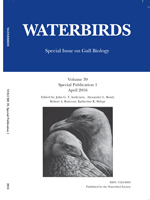Information on the status, trends and dynamics of large gulls nesting in northern areas is limited. Herring (Larus argentatus) and Great Black-backed (L. marinus) gull breeding colonies were surveyed in coastal Labrador, Canada, from 1998 to 2003 to assess short-term population trends and colony site dynamics. Between 1998 and 2003, 117 islands distributed across three major archipelagos were surveyed on two or more occasions, documenting 1,054 gull clutches. Nesting was noticeably uniform across islands in the archipelagos, with mild aggregations noted in only one region. Incidence (the proportion of islands occupied by Herring and Great Black-backed gulls) declined over the study period, and there were fewer colonization events than abandonment events (also suggesting declines). Abundance declined in one region and overall at 2.9% per year over the 6-year period. Colony abandonment rates did not detectably decline with increasing colony size, and island isolation, indexed by the number of islands within 5 km, was not related to colonization rates. Herring and Great Black-backed gulls in Labrador showed positive incidence and abundance relationships at two spatial scales, indicating that more islands were occupied at larger local population sizes. This study revealed that colony-level metrics can be combined with population trend analysis to allow a richer assessment of the dynamics of colonial species.
How to translate text using browser tools
1 April 2016
Colony Dynamics of Large Gulls Nesting in Labrador, Canada
Gregory J. Robertson,
Keith G. Chaulk
ACCESS THE FULL ARTICLE

Waterbirds
Vol. 39 • No. sp1
April 2016
Vol. 39 • No. sp1
April 2016
abandonment
colonization
colony site dynamics
Great Black-backed Gull
Herring Gull
Labrador
Larus argentatus




